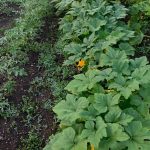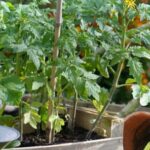Covering is an essential practice for maintaining healthy and productive vegetable gardens. It helps protect plants from harsh weather conditions, suppresses weeds, conserves moisture, and enriches the soil. One popular type of covering that has gained significant popularity among gardeners is hay. Hay offers numerous benefits and advantages that make it an effective option for protecting vegetable gardens.
Hay serves as a protective layer around plants, acting as a barrier against extreme temperatures and providing insulation during both hot summers and cold winters. Its ability to retain moisture is another key benefit, ensuring that plants have access to adequate water even during dry periods. Moreover, hay aids in suppressing weed growth by blocking sunlight from reaching the soil’s surface where weeds would thrive.
Another advantage of using hay as a covering material for vegetable gardens is its ability to enrich the soil with nutrients. As hay decomposes over time, it releases organic matter into the soil, improving its fertility and promoting healthier plant growth. This makes it ideal for organic gardening practices where natural fertilizers are favored.
Aside from these benefits, hay is readily available in many areas, making it easily accessible for gardeners looking to cover their vegetable beds. However, while hay is an efficient choice for most gardeners, there are alternative coverings similar to hay that can also provide effective protection for vegetable gardens.
Why Hay is an Effective Covering for Vegetable Gardens
Hay is widely recognized as an effective covering for vegetable gardens due to its numerous advantages. One of the primary benefits of using hay as a covering is its ability to retain moisture in the soil. The densely-packed nature of hay keeps water from evaporating quickly, helping to prevent drought stress in plants and reducing the frequency of watering needed.
In addition to moisture retention, hay also aids in regulating temperature in vegetable gardens. The layer of hay acts as insulation, protecting the roots of plants from extreme temperatures and fluctuations. This can be particularly beneficial in regions with harsh climates, where temperature extremes can have detrimental effects on plant growth.
Another advantage of using hay as a covering is its ability to suppress weeds. The thick layer of hay prevents sunlight from reaching weed seeds, inhibiting their germination and growth. This significantly reduces the amount of time and effort required for weed control, allowing gardeners to focus on nurturing their vegetable crops rather than constantly battling unwanted vegetation.
Furthermore, using hay as a covering material can enrich the soil with nutrients over time. As the hay decomposes, it releases essential organic matter into the soil, improving its fertility and providing a steady supply of nutrients for vegetable plants. This nutrient enrichment can result in healthier plants with improved yield and vitality.
| Advantages |
|---|
| Moisture retention |
| Temperature regulation |
| Weed suppression |
| Nutrient enrichment |
Straw as an Alternative Covering
Straw, like hay, is another popular option for covering vegetable gardens. While similar in some ways to hay, straw has its own unique set of benefits and drawbacks. One advantage of using straw as a covering is its ability to insulate and protect plants from extreme temperatures. The straw layer acts as a barrier between the plants and the elements, helping to regulate temperature fluctuations and prevent damage caused by hot or cold weather.
Another benefit of using straw is its availability. Straw can typically be obtained easily and at a lower cost compared to hay. It is often a byproduct of grain production and can be sourced locally from farmers or agricultural suppliers. This makes it an accessible option for gardeners who may not have easy access to hay.
When it comes to soil health, there are mixed opinions about using straw as a garden covering. Some argue that straw can negatively impact soil health by depleting nitrogen levels. Straw contains a high carbon-to-nitrogen ratio, which means that it takes longer to break down compared to other organic materials. During decomposition, microbes in the soil consume nitrogen as they break down the carbon-rich straw, potentially temporarily reducing the nitrogen available for plant uptake.
Despite this potential drawback, many gardeners still choose to use straw as a covering because of its other benefits. When applied correctly with proper nitrogen supplementation through fertilization or adding compost, the negative impact on soil health can be minimized or mitigated entirely.
Overall, while hay remains one of the most popular coverings for vegetable gardens, straw offers unique advantages as an alternative option. Its ability to insulate and protect plants and its widespread availability make it an attractive choice for many gardeners. However, careful consideration should be given to its impact on soil health and appropriate measures taken to ensure nutrient levels are maintained for optimal plant growth.
Wood Chips as a Natural Covering
Wood chips are an alternative natural covering for vegetable gardens that offer a range of benefits. One of the main advantages of using wood chips as a covering is their ability to regulate moisture in the garden.
Wood chips act as a mulch, forming a protective layer on top of the soil that helps to retain moisture. This can be especially beneficial in dry climates or during periods of drought, as it reduces the need for frequent watering and helps plants withstand dry conditions.
In addition to moisture regulation, wood chips also help with weed control in vegetable gardens. The layer of wood chips acts as a barrier that inhibits weed growth by blocking sunlight from reaching weed seeds. This reduces the need for manual weeding and saves time and effort in maintaining the garden. However, it is important to note that wood chips should be used in conjunction with a weed barrier fabric or cardboard layer beneath them to provide effective weed suppression.
Organic decomposition is another advantage of using wood chips as a natural covering. Over time, the wood chips break down and decompose, adding organic matter to the soil. As they decompose, they release valuable nutrients into the soil, enriching it and providing a source of nutrition for plants. This process also enhances soil structure and fertility over time, resulting in healthier plants and increased yields.
When using wood chips as a covering for vegetable gardens, it is important to consider the type of wood being used. Hardwood varieties are preferred over softwoods because they take longer to decompose and do not rob nitrogen from the soil during decomposition. It is also worth noting that freshly chipped or shredded wood should be allowed to age for several weeks before applying it as a garden covering, as fresh wood can leach nitrogen from the soil.
Overall, wood chips offer an eco-friendly and aesthetically pleasing option for covering vegetable gardens. They provide moisture regulation, weed control, and organic decomposition benefits that promote plant health and enhance soil fertility. By carefully selecting and properly using wood chips in the garden, vegetable gardeners can create a sustainable and visually appealing environment for their plants to thrive.
Compost as a Protective Covering
Enriching Soil with Nutrients
Using compost as a protective covering for vegetable gardens offers numerous benefits, starting with its ability to enrich soil with vital nutrients. Compost is created through the process of decomposing organic materials such as food scraps, yard waste, and other biodegradable materials. As it breaks down, compost releases essential nutrients like nitrogen, phosphorus, and potassium back into the soil.
These nutrients are crucial for healthy plant growth and development. By implementing compost as a protective covering in vegetable gardens, gardeners can ensure that their plants receive a steady supply of these essential nutrients throughout the growing season. In turn, this improves overall plant health, boosts crop yield, and enhances the flavor and nutritional value of harvested fruits and vegetables.
Improving Water Retention
Another significant advantage of using compost as a protective covering is its ability to improve water retention in the soil. Compost acts as a sponge-like material that absorbs and retains moisture efficiently. This means that water will be available for plants over an extended period, reducing the need for frequent watering.
By applying compost as a covering layer in vegetable gardens, gardeners can help prevent water evaporation from the soil surface. This not only conserves water but also reduces the risk of drought stress on plants during dry spells or hot summer months. Additionally, improved water retention results in more efficient root uptake of nutrients from the soil.
Suppressing Weed Growth
Weeds are unwelcome intruders in any garden as they compete with desirable crops for resources like sunlight, moisture, and nutrients. Fortunately, using compost as a protective covering can help suppress weed growth effectively. When spread evenly over bare soil or around young seedlings, compost creates a physical barrier that inhibits weed germination by blocking sunlight from reaching weed seeds.
Furthermore, by smothering existing weeds with a thick layer of compost, gardeners can prevent them from establishing themselves and spreading throughout the garden. This natural weed suppression method reduces the need for frequent weeding or the use of synthetic herbicides, creating a healthier and more environmentally friendly gardening practice.
Mulch
Mulch is an effective and versatile garden cover that offers a range of benefits for vegetable gardens. There are various types of mulch to choose from, including organic, inorganic, and biodegradable options. Regardless of the type, mulch provides several advantages such as moisture conservation, temperature moderation, and weed prevention.
One of the main advantages of using mulch as a garden cover is its ability to conserve moisture. Mulch acts as a barrier between the soil and the air, reducing evaporation and helping to retain water in the soil.
This can be particularly beneficial during hot summer months or in regions with limited rainfall. Organic mulches, such as straw or wood chips, are especially effective at retaining moisture because they break down over time and release organic matter into the soil, which improves its water-holding capacity.
Another benefit of using mulch is its ability to moderate soil temperature. Mulch helps to keep the soil cooler in hot weather by providing shade and insulation. It also acts as an insulating layer during colder months, preventing extreme temperature fluctuations that can harm plant roots. This is particularly important for maintaining optimal conditions for vegetable growth.
Furthermore, mulch plays an essential role in suppressing weed growth. By covering the soil surface, mulch prevents sunlight from reaching weed seeds and inhibits their germination. Additionally, some types of organic mulch contain compounds that act as natural herbicides or inhibit weed seedling growth. This reduces the need for manual weeding or the use of synthetic herbicides, making it an eco-friendly option for vegetable gardens.
Plastic Covers
Retaining Heat
One of the major advantages of using plastic covers as a covering for vegetable gardens is their ability to retain heat. Plastic covers create a greenhouse effect by trapping heat from the sun, creating a warmer environment for the plants. This can be especially beneficial for gardeners in colder climates or those who want to extend the growing season. The retained heat helps promote plant growth and provides protection against low temperatures.
Protecting Against Frost
In addition to retaining heat, plastic covers serve as excellent barriers against frost damage. When placed over the vegetable garden at night or during cold weather spells, plastic covers can create a protective shield that prevents frost from reaching the plants. This is particularly important for sensitive vegetables and crops that are susceptible to frost damage. By using plastic covers, gardeners can mitigate the risk of losing their plants due to freezing temperatures.
Pest Control
Another advantage of using plastic covers as an alternative to hay in vegetable gardens is their effectiveness in controlling pests. Plastic covers act as a physical barrier that keeps insects and other pests away from the plants. They also help prevent diseases transmitted through soil-borne organisms. By creating a seal around the garden beds, plastic covers can greatly reduce pest infestation and minimize crop losses caused by insect damage.
However, it’s essential to consider some potential drawbacks and environmental concerns associated with using plastic covers.
Environmental Concerns and Potential Drawbacks
Plastic covers are not biodegradable and can have adverse impacts on the environment if not properly disposed of after use. They may contribute to pollution when they break down into microplastics or are not recycled correctly. Additionally, plastic covers reduce air and water circulation in the soil, which can lead to poor drainage and increase the risk of fungal diseases.
Furthermore, plastic covers may require additional equipment such as hoops or frames to maintain their shape and keep them well-anchored. This can add extra costs and labor for gardeners. Moreover, using plastic covers too frequently or for an extended period may prevent beneficial insects from accessing the crops, disrupting natural ecosystems.
Living Cover Crops
Living cover crops offer a natural and sustainable alternative to the traditional hay covering for vegetable gardens. These cover crops include a variety of plant species such as clover, grasses, and legumes that provide numerous benefits to the garden.
One major advantage of using living cover crops is their ability to suppress weeds. The dense growth of these plants can outcompete and shade out invasive weed species, reducing the need for manual weeding or herbicide use. This not only saves time and effort for gardeners but also reduces the competition for resources between weeds and vegetables.
Furthermore, living cover crops play a crucial role in improving soil fertility. Many legume cover crops have nitrogen-fixing abilities through a symbiotic relationship with nitrogen-fixing bacteria in their root nodules. These bacteria convert atmospheric nitrogen into a form that plants can utilize, ultimately enriching the soil with this essential nutrient. Additionally, the decomposing plant material from living cover crops adds organic matter to the soil, improving its structure and increasing its capacity to hold water and nutrients.
Another benefit of using living cover crops is their ability to attract beneficial insects to the garden. Certain flower-producing cover crop species like clover can attract pollinators such as bees and butterflies, helping ensure successful fruit set in vegetable plants. Additionally, these plants can serve as habitat for predatory insects that naturally control common garden pests like aphids or caterpillars.
Conclusion
In conclusion, there are several types of coverings similar to hay that can effectively protect and enhance vegetable gardens. Hay itself is a popular option due to its ability to retain moisture, regulate temperature, suppress weeds, and enrich the soil with nutrients. However, if hay is not readily available or if gardeners are looking for alternative options, there are several other coverings to consider.
Straw can serve as a viable alternative to hay. It offers insulation and protection for plants, and it is often more readily available than hay. However, it may not enrich the soil as effectively as hay does and may impact soil health over time.
Wood chips provide both practical and aesthetic benefits. They help regulate moisture levels in the soil, control weed growth, and decompose naturally over time. They also add a visually appealing element to the garden. However, wood chips may take longer to break down compared to other coverings.
Compost is another protective covering option that offers numerous benefits. It enriches the soil with essential nutrients, improves water retention capacity, and suppresses weed growth effectively. Compost is a valuable choice for gardeners who prioritize soil fertility and sustainable practices.
Mulch is an excellent choice for moisture conservation, temperature moderation, and weed prevention in vegetable gardens. Different types of mulch – organic, inorganic, or biodegradable – offer specific advantages depending on individual needs and preferences.
Plastic covers have their own set of benefits such as heat retention, frost protection,and pest control. However,gardeners must also be mindful of potential environmental concerns associated with plastic use.
Lastly,living cover crops like clover,native grasses,and legumes offer an organic,sustainable alternative.They suppress weeds,natural fertilizer,and attract beneficial insects,varied range of options ensures that gardeners can choose according to their specific requirements.
Ultimately,gardeners should carefully assess their needs,priorities,and resources when deciding on a covering material for their vegetable gardens. Each type of covering has its own advantages and drawbacks, and the choice depends on factors such as availability, environmental impact, soil health, and desired outcomes. By selecting the right covering material, gardeners can create a favorable environment for their vegetable gardens to thrive and flourish.
Frequently Asked Questions
Which mulch is best for vegetable gardens?
The best mulch for vegetable gardens depends on various factors such as soil type, climate, and the specific needs of the vegetables being grown. Organic materials like straw or hay can be a popular choice as they help retain moisture, suppress weeds, and gradually release nutrients into the soil as they break down.
Wood chips or shredded bark can also be suitable options, providing insulation against temperature fluctuations and preventing erosion. Ultimately, it is important to consider the overall health of the plants and soil when selecting mulch for a vegetable garden.
What is the best thing to cover a flower bed with?
When it comes to covering a flower bed, there are several options that can work well depending on individual preferences and requirements. Organic materials such as compost or well-rotted manure can enrich the soil while acting as a protective layer for flowers. These natural choices enhance soil structure, retain moisture, and add valuable nutrients to support healthy growth.
Another option could be using decorative stones or gravel to create an aesthetically pleasing look while inhibiting weed growth and conserving moisture in the soil. Ultimately, the best choice for covering a flower bed will depend on factors like personal taste, region-specific considerations, and the specific needs of the flowers being cultivated.
What kind of mulch is best for raised beds?
Raised beds offer unique gardening opportunities due to their improved drainage and better control over soil quality compared to traditional garden beds. The best mulch for raised beds typically consists of organic materials that improve water retention and nurture healthy plant growth. Compost can be an excellent option as it adds beneficial nutrients to the soil while facilitating water permeability and providing insulation against extreme temperatures.
Additionally, straw or grass clippings can serve as effective mulch choices since they help regulate moisture levels in raised beds by reducing evaporation and preventing weed growth. Ultimately, choosing a mulch for raised beds should focus on promoting optimal growing conditions for plants while considering factors such as climate and specific plant needs.

If you’re looking to get into vegetable gardening, or are just looking for some tips on how to make your current garden better, then you’ve come to the right place! My name is Ethel and I have been gardening for years. In this blog, I’m going to share with you some of my best tips on how to create a successful vegetable garden.





